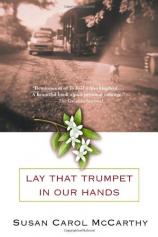Reading Group Guide
Discussion Questions
Lay That Trumpet in Our Hands

1. Lay That Trumpet In Our Hands opens with an evocative description of Florida as the "baby sister to the Belles." What do these initial paragraphs indicate about the state's economic and social history?
2. Before reading the novel, were you aware of the Ku Klux Klan's activities in Florida during the first half of the twentieth century? Do you believe that race relations evolved differently in Florida than in the rest of the South?
3. In what ways do the McMahons embody Florida's contradictions?
4. What characteristics does a young narrator impart to a tale as wrenching as Reesa's? Which traits make her a particularly appropriate guide for us? How might the story have changed if told from her brother Ren's point of view?
5. Do Reesa's role models—her mother and father, Doto, Luther, and Armetta—provide her with contradictory or consistent messages about human nature? What are some examples?
6. In chapter nine, May Carol's mother begs Armetta to return to her job in their household. What does this scene reveal about the balance of power between adults and children in Mayflower, and between blacks and whites? Were you surprised that Mr. Garnet made no effort to hide his KKK robe from Armetta?
7. Discuss the author's many references to baseball. How does baseball enhance the novel's plot and tone?
8. Religion figures prominently in Lay That Trumpet In Our Hands, from the Marvin's lessons in Bible study to the horrific Klan bombings of Catholic and Jewish citizens. How do these myriad experiences shape Reesa's understanding of God? How does her faith change throughout the book?
9. The Red Scare is an important historical backdrop for the novel. In what way did the Klan align itself with those who feared a Communist insurgency?
10. Whose "hands" are implied by the title, in your opinion? Who are their contemporary equivalents?
11. What does the correspondence between Reesa and Vaylie teach both girls about life outside their own families? What do the letters convey to us that isn't disclosed in the main storyline?
12. Two background characters, Maybelle Mason and Lucy Garnet, add an interesting perspective to the role of women in Mayflower. In what way does each woman's tragedy affect your understanding of this town?
13. The women of Luther's "C.I.A." were crucial to a courtroom victory. How do they compare to the novel's other female characters?
14. The Florida landscape makes an intriguing backdrop for this novel, complete with a swimming hole restored at the book's conclusion. Discuss the influence of setting on your imagination as you read Lay That Trumpet In Our Hands.
15. In her author's note, Susan Carol McCarthy emphasizes the fact that the characters Reed Garnet, J.D. Bowman, and their families are completely fictional: "The real Klansmen who roamed the back roads and groves of our area, including those who were indicted by the federal grand jury, have their own stories. Which, of course, are theirs to tell." What do you imagine those stories might say? What motivated this novel's antagonists?
16. How did the civil rights movement affect your community?
17. Susan Carol McCarthy began writing this novel as a gift for her father, whose heroism in Florida inspired the character of Warren McMahon. Who are the Warrens and Luthers in your life?
Lay That Trumpet in Our Hands
- Publication Date: April 1, 2003
- Genres: Fiction
- Paperback: 288 pages
- Publisher: Bantam
- ISBN-10: 0553381032
- ISBN-13: 9780553381030







